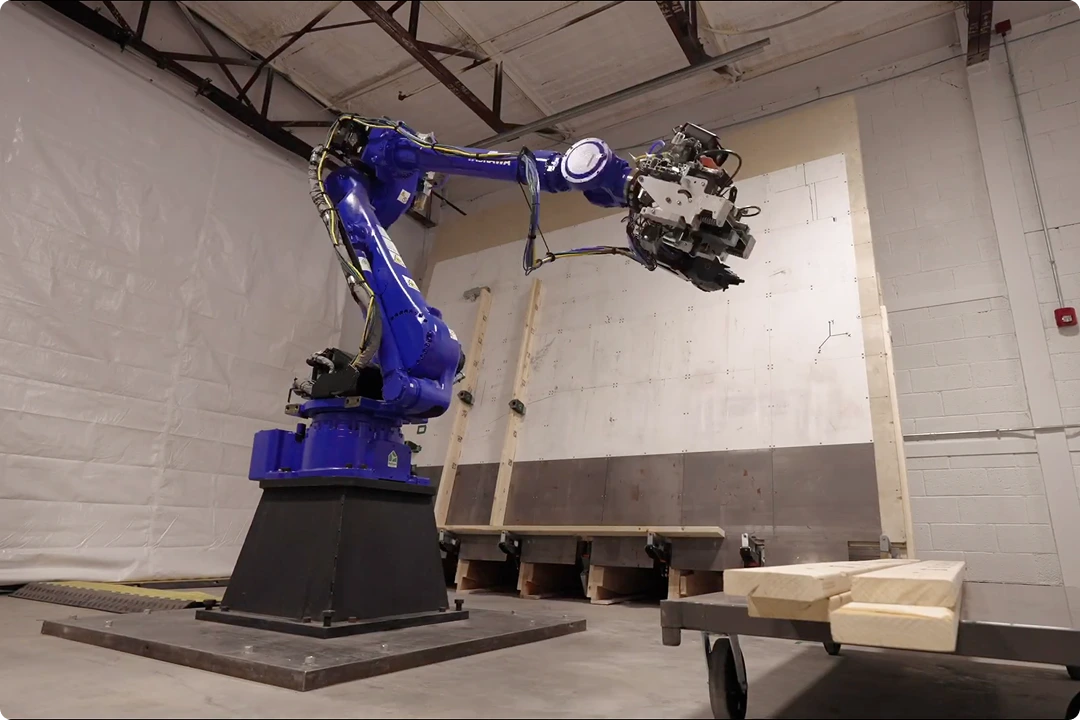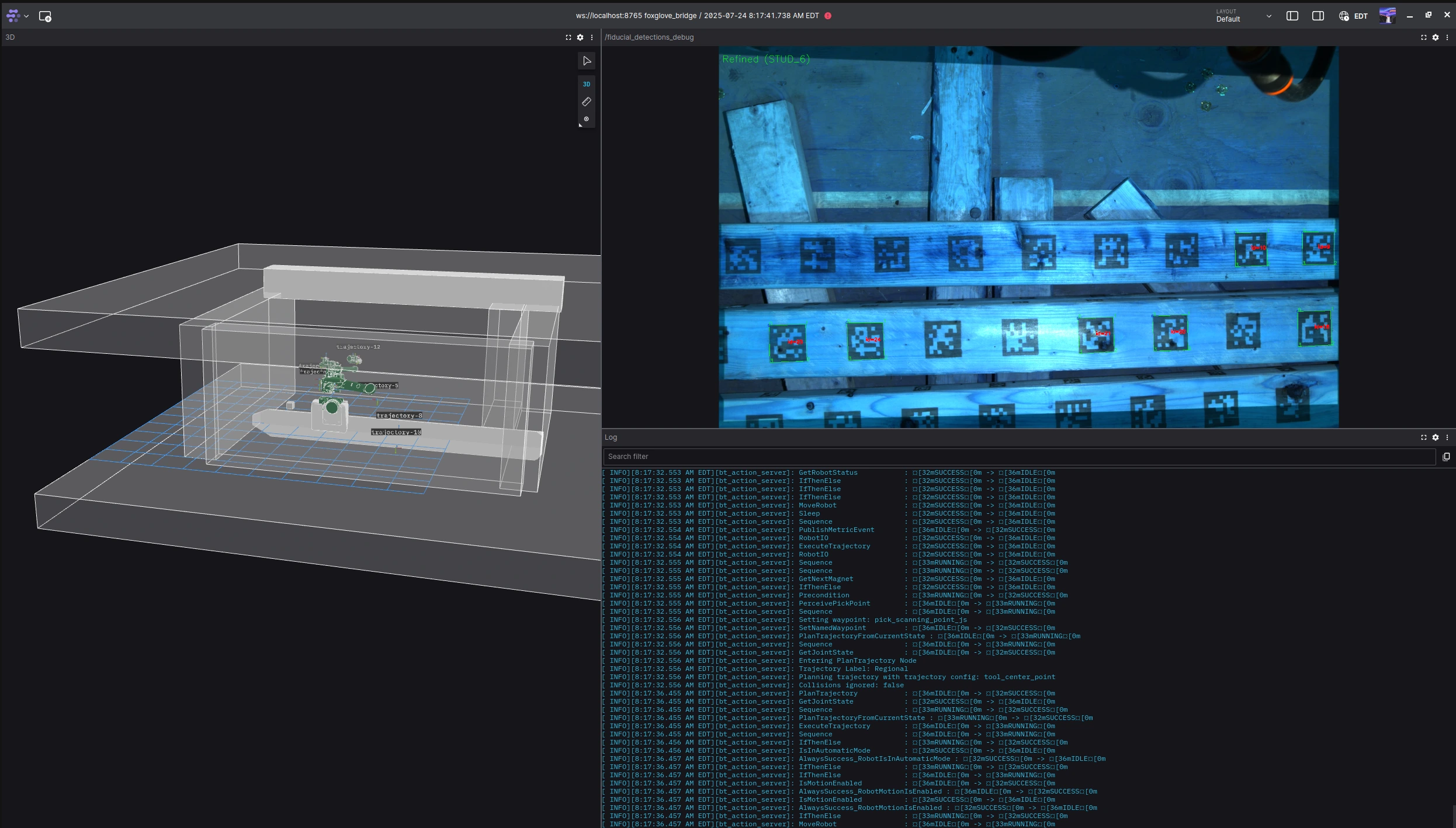


Reframe Systems is on a mission to build resilient homes faster, more predictably, and without compromise using robotics, AI, and local microfactories.
Founded: 2022 in Massachusetts, United States
Size: ~50 (Series A)
“With Foxglove I can virtually look over the robot’s shoulder, see what it’s thinking, and have us rolling again in minutes.” Joseph Schornak, Robotics Lead, Reframe Systems
Reframe Systems is reinventing homebuilding by applying automation and robotics to modular construction. Operating with a vertically integrated model, the company designs, models, and builds in localized microfactories. From architects crafting high-efficiency floorplans to engineers programming robots that frame walls in a factory environment, Reframe’s approach drastically reduces build time and increases quality. At the heart of their operations is their 1st robotic platform called Acadia, designed to fabricate structural wall panels with flexibility, speed, and precision. Their goal: deliver high-quality housing that’s faster, more predictable, and more resilient than traditional construction to meet rising housing demands.

Before integrating Foxglove, Reframe’s debugging workflows were reactive, manual, and constrained by the limitations of legacy tools. Using RViz as their primary visualization interface, engineers could only investigate issues live—if a robot failed during operation and wasn’t diagnosed at the moment, there was no ability to reconstruct or analyze the problem afterward. The team attempted to record MCAP files, but replaying them in practice proved unreliable, often rendering their data logs useless. This made failures opaque and debugging painfully slow, especially in a high-mix environment where not all issues could be easily reproduced.
Routine development tasks—like debugging motion planning trajectories or validating point clouds during camera calibration—became time sinks, compounded by limited data recording and visualization capabilities. Hardware constraints also played a role; GPU-heavy workloads meant team members needed high-spec gaming laptops just to run RViz effectively. These friction points weren’t just technical annoyances—they blocked the team from moving quickly, scaling systems efficiently, and focusing on the core innovations that set Reframe apart.
“I built a custom log-offload pipeline at my last job; Foxglove gives us the same capability out of the box.” Fifi Yeung, Founding Engineer, Reframe Systems
Reframe first encountered Foxglove at the 2023 Robotics Summit, where a recommendation from a shared investor nudged the team to take a closer look. What started as a curiosity turned into an indispensable part of their workflow within an hour of hands-on use. During early trials, the team leveraged Foxglove to troubleshoot a subtle but critical issue: a motion planning misconfiguration was causing the robot to execute a joint move instead of a linear trajectory—a nuance invisible to the naked eye, but obvious when visualized with Foxglove’s coordinate plots. The platform’s ease of use and powerful visualization instantly validated their suspicions and delivered insight in under 60 minutes.

From there, Reframe built Foxglove Agent into their core infrastructure, automating uploads from all work cells. Engineers now visualize and debug robot sessions using Foxglove, and the team has begun integrating event logging to track system behavior down to every nail fired. Whether diagnosing motion anomalies or verifying perception pipelines, Foxglove became a central interface for production operations, research, and development alike.

“The very first time we tried Foxglove we pinpointed a mis-configured trajectory in under an hour—something invisible to the naked eye.” Fifi Yeung, Founding Engineer, Reframe Systems
With Foxglove, Reframe moved from reactive firefighting to proactive engineering. The shift was immediate: a robot failing to pick a stud, which previously would’ve sparked a time-consuming investigation, now takes just minutes to diagnose via replayed logs. Instead of launching a full Q&A session or rechecking every input, engineers simply “look over the robot’s shoulder” through Foxglove’s visualization tools to understand what went wrong—then adjust accordingly and resume production.
This efficiency boost didn’t just save time—it enabled Reframe to scale. As they brought new work cells online with differing physical configurations, Foxglove’s consistent tooling, data tagging, and recording formats ensured that no extra engineering effort was needed to maintain observability. Engineers no longer have to rebuild internal tooling for data offload or logging; Foxglove handles it seamlessly. Its cloud-first architecture lightened hardware requirements too, allowing parts of the team to move to Mac-based development—a significant shift from their former reliance on GPU-heavy Windows setups.
Foxglove hasn’t just helped Reframe improve; it’s helped them evolve. By reducing time-to-diagnosis, standardizing workflows, and eliminating redundant infrastructure, Foxglove has unlocked new velocity in robotic construction—accelerating the company’s mission to build smarter, faster, and for more people.